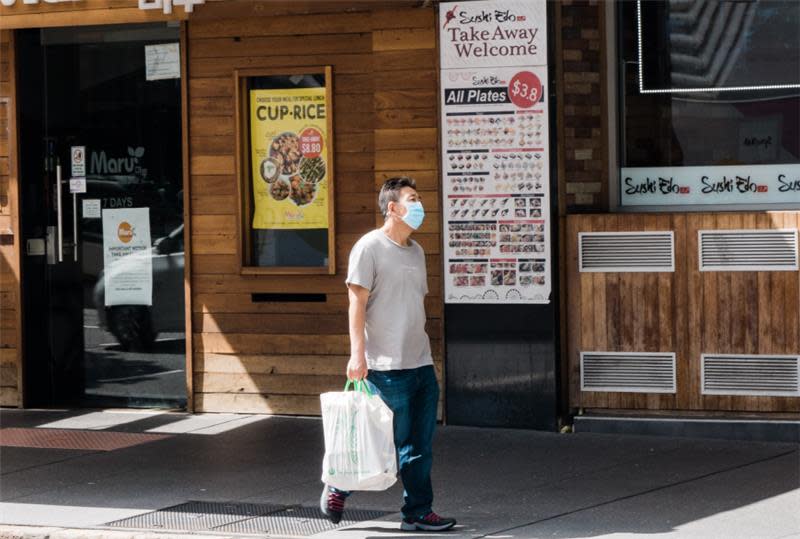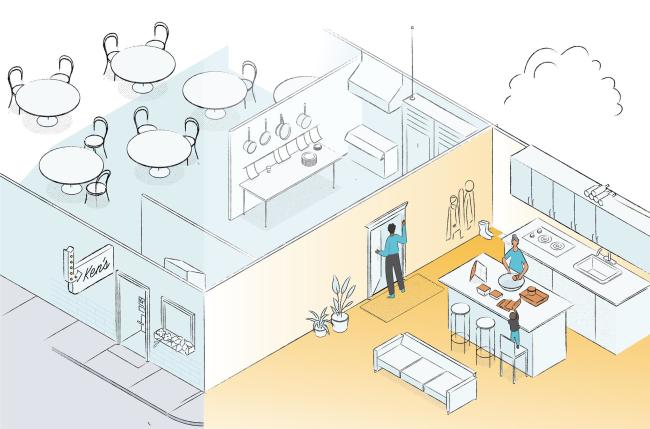
COVID-19 has hurt the restaurant industry. Badly. We’ve seen many US-based restaurants pivot to adapt to these uncertain times. While we don’t yet know which of these pivots will become permanent changes to the post-pandemic restaurant experience, we’re certain that restaurants must develop a deep understanding of their customers and employees to connect today (the abnormal) and tomorrow (the next normal).
To that end, we conducted ethnographic interviews and a comprehensive, anonymous survey with restaurant customers to understand how they’re coping with the current times and what they anticipate will be the new normal. This post highlights five major insights that we uncovered around why people eat at restaurants and their food safety expectations during the pandemic. We hope they guide you as you continue to evolve your business.
Baseline of Behaviors
To set the stage, we explored people’s food behaviors, from cooking and getting groceries to ordering from restaurants.
58% of customers surveyed have been cooking more at home since the pandemic, and 44% have been ordering food from restaurants, albeit less often than before. Only 48% of the respondents who take away from restaurants do so approximately 1-2 times per week, down 22% from before the pandemic. In fact, most people now order food 1-2 times per week or less (see Figure 1) because they’re cooking more. The drop is putting pressure on restaurants as they struggle to stay open and profitable. As states start to open dine-in services, it’s unclear if customers will be showing up. Interestingly, the percentage of people who usually order a meal 1-3 times per month has increased because they want to support a local business they care about or take a break from cooking.

Figure 1: (Pre-Pandemic) Q: How often would you get food from a restaurant before the pandemic? "Getting food" means dining in a restaurant, getting fast-food via pick-up or drive-through, or getting delivery. (Now) Q: Think about how your behavior has changed since the pandemic began. How often are you getting food from a restaurant now?
When it comes to getting groceries, fewer people are shopping in-person. The number dropped from 75% of primary grocery shoppers shopping in-person pre-pandemic to only 47% of people currently. Instead, we’ve seen a rise in delivery and curb-side pickup with 22% and 6% more people choosing these services during the pandemic. One trend we are seeing is that restaurants are selling groceries and grocery stores are selling restaurant food.
Insights: Why People Currently Order from Restaurants
1. I want something familiar.
It’s all about craving an escape from the quarantine routine. The chief reason consumers order familiar foods is to take a break from cooking and all the household responsibilities they now have. 69% of respondents have only ordered from restaurants they have always ordered from. A few notable reasons include:
• Saving my favorite spots: “[I] want to support my favorite restaurants to survive.”
• Less risky to go with familiarity: “I don’t know of any new restaurants with a trustworthy policy”; “[I believe in] loyalty and knowing what you are getting during a time when so much is unknown.”
• A small reminder of the world: “We knew eating food from there was a brief reminder of the outside world.”
• Pleasing picky eaters: “[My] family is picky and wants tried-and-true favorites.”
What are people ordering? 85% of people are getting ready-to-eat hot meals from restaurants and are not buying frozen or many meals in the hopes of stocking up. Some of the most notable comfort foods people are seeking now include:
• Pizza
• Pasta
• Things with cheese (mac-n-cheese, nachos)
• Ice cream
• Soup
• Chocolate
• Cookies
• Bread
• Chinese, Thai, and Indian food
What you can do
Explore how your restaurant might offer meals that can be eaten the same day, are comfort foods, and feel familiar to frequent and long-term patrons. Are there ways you could make them feel appreciated that they’re helping to save your restaurant, such as through a loyalty program during this extra difficult time?
As you look to the future, how can you recapture “the familiar” of going to restaurants when we may never truly get back to normal? For inspiration, a couple restaurants in the Boston area are experimenting with Zoom to recreate dine-in and catered-party experiences in people’s homes to foster a sense of community during a time of individual isolation.
2. Support my new quarantine hobby: cooking!
Customers are spending more time at home cooking, as both a hobby and out of necessity, during the pandemic. One respondent we interviewed said, “I am cooking because I want to take a break from looking at the screen… now if we got food delivered, we wouldn’t get to take a break to make the food.” This illustrates consumers’ need to disconnect from work and friends as they spend many hours of the day zooming around online.
To solve this challenge, we asked respondents which items they’d most likely try if social distancing continues for much longer. 30% said they would be interested in a meal-subscription service from a small/local chain, while only 4% are interested in a subscription from a national chain. Consumers hunger for local, more bespoke food, and want to support those restaurants at risk of going out of business.
Similarly, many items used for cooking and cleaning are hard to find in grocery stores. The top-five item groups people would buy from a restaurant are (see Figure 3):
• Bakery goods (e.g. bread, flour)
• Dairy (e.g. milk, eggs, cheese)
• Cleaning supplies (e.g. sanitizing wipes, bleach)
• Paper products (e.g. paper towels, toilet paper, tissues)
• Shelf-stable foods (e.g. beans, peanut butter)
Figure 2: Q: If you couldn't find these at the store, which of the following categories of items would you be interested in buying from a restaurant right now? Select all that apply.
What you can do
So how can your restaurant support people’s cooking hobbies right now? Small restaurants might provide meal kits of their most beloved dishes for customers to prepare at home. Both small and large restaurants might also determine how they can sell in-demand groceries to patrons to diversify their revenue streams.
Insights: Food Safety Perceptions
3. Robots and heat make great virus shields.
35% of customers believe that when it comes to consuming food prepared outside the home, being able to eat hot or reheatable meals is safest because of heat’s sanitizing properties. While the CDC says, “Currently, there is no evidence to support transmission of COVID-19 associated with food,” it still recommends proper food safety measures, including cooking foods “to the right temperatures to kills harmful germs.” Nevertheless, we uncovered that the current sentiment is that people are vectors that can contaminate food; respondents believe that any foods prepared with automation or are cooked to high heats are safe to consume. For example, Pizza Hut implemented a procedure for pizza that comes out of the oven—it’s transferred into the box without someone ever touching it.
What you can do
What might restaurants do to highlight the sterility of their food or the temperature at which it was prepared? Are there ways to automate the food-preparation process or decrease human contact, while preserving employee jobs, to give consumers confidence their food hasn’t been contaminated?
4. Seeing is believing when it comes to safety precautions.
Despite 45% of people seeing all restaurants as posing a risk right now, it hasn’t stopped them from ordering food from restaurants. Over 30% of respondents said their trust in restaurants is a leap of faith, but it is bolstered by knowing the safety precautions ahead of time, especially for those who are or live with someone in the high-risk category for the coronavirus. One interesting tidbit our survey uncovered is that 12% of respondents are not trusting of national chains compared to just 1% of respondents not trusting local restaurants. Sarah, an interviewee, said, “What helps me build confidence is having a list of people that prepared [the food] and the things they were doing to keep safe, like wearing gloves. It helps to know that just a few people worked on it, not a thousand people in an assembly line where everybody could have touched it.”
What you can do
What can your restaurant do to communicate through multiple channels, especially with long-time patrons, what your safety precautions are, the number of people touching food at any given time, and how you’re prevent those that are sick from coming in? How might you encourage the leap of faith your customers take by rewarding this loyalty?
5. Use multiple layers of packaging.
Customers believe that multiple layers of packaging keep food safe from all those who have handled it. A considerable 63% of consumers see all restaurants posing a risk right now, and they take some extra measure to sanitize food packaging to decrease the risk of contracting the virus.
Survey respondents ranked the top-three things that make them feel the safest about delivered food. Truly contactless delivery was the highest-rated category, at 23% of respondents, regarding what made them feel safest about their delivered food. The second- and third-highest-rated categories were knowing that food preparers and drivers are wearing PPE at 16% and 15% of respondents respectively. These statistics indicate that there is significant interest from consumers in knowing the precautionary measures restaurants and delivery companies are taking to reduce their risk of catching the coronavirus so they can enjoy food in the comfort of their own homes.
What you can do
We know that PPE is in short supply right now, and that just because restaurants open and implements safety protocols doesn’t mean that consumers are ready to dine in just yet. We anticipate that delivery will still be the norm for months to come. As a result, we urge restaurants to think about how they can showcase that the food or packaging hasn’t been tampered with to customers. For example, you could double down on outer layers of removable or tamper-proof packaging.
The Next Normal for Restaurants
Through our research, we found that people will continue to cook more, practice good hygiene, and tip delivery drivers more (now that they understand how important these people are and how vulnerable their livelihoods are; the virus exposed how precarious gig work truly is). One survey respondent stated, “The pandemic has shed light on inequities in our supply chain that I hadn't focused on before. I also wasn't aware of what a large cut services like DoorDash take from restaurants (and that those cuts do not necessarily go to the driver). I'm also more aware of how vulnerable local, non-chain establishments are and feel a heightened sense of duty to support them, pandemic or not.”
Only a small percentage of people—at 7% or less—believe they will continue grocery delivery, meal delivery, and meal-kit deliver once the pandemic is over. While these may be great opportunities for restaurants at the moment, they may not be a sustainable source of revenue in a year or two. But, innovating and piloting ideas are the only way to know. Each restaurant businesses has its own reason for existing. It offers a specific value proposition for a particular group of customers.
In the On the Media podcast, guest Derek Thompson of The Atlantic predicts that “foods that deliver well [will expand] their footprint in the American restaurant business.” He also discusses what happened because of Prohibition. It changed the kinds of foods and tastes of foods that were enjoyed in America. A lot of fine dining restaurants ended up closing because they were reliant on alcohol sales, so many restaurants pivoted to lunch-car diners and offered “foods that kids could enjoy with sober parents… hot dogs, hamburgers, and milkshakes.” These foods became foundational to the American culture as fast-food chains arose.
What we can learn from our past and our current situation is that the evolving types of foods and increases in delivery may be here to stay, even if respondents predict that they will gradually return to dining in once the pandemic is over. The Prohibition story suggests that the smartest restaurateurs understand that shifting tastes and business models are opportunities. And, while the current moment is a bad time for the old way of doing things, the uncertain future holds the promise of producing some essential new fare.
Thank you to all that collaborated and contributed to this report, especially Buck Sleeper, Alison Kotin, Megan Welker, and Jared Steinmark.
Image by Nicolas Weldingh on Unsplash
Research Methodology
For this report, we surveyed over 283 respondents nationwide using Qualtrics, the majority being restaurants customers from Massachusetts, where our Boston studio is located. The survey focused on customers that have previously ordered or currently order food from restaurants. In terms of demographics, some quick stats include:
• The median age group that completed the survey was 25-34 years old;
• The median annual household income is $100,000-$149,000;
• 72% identified as female
• Massachusetts, California, New York, Washington, and Texas were the top five states represented in descending order;
• 51% live in suburban areas while 45% live in urban areas;
• The majority of respondents live with others (33% live with a partner, 35% live with a partner and children, and 13% live with roommates);
• 86% are ethnically White and 9% are Asian.




